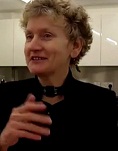
Of course we’ve seen that structure before. It’s in the same family as films like Rashomon and Run Lola Run and I’ve given that family of forms the name of ‘consecutive stories ‘( a horribly clumsy name but usefully descriptive). Joint Enterprise belongs to the sub group of consecutive stories that I call ‘Different Perspectives’. It shows its family resemblance here because, typical of this form, its theme is the slippery nature of truth, which it depicts through three versions of the same events and it's about a criminal subset of society. More about consecutive stories
What sets Joint Enterprise apart - where it’s breaking new ground and where we can learn from it - is in the particular use it’s making of direct-to-camera monologues, intercut with flashbacks to different versions of the same crime.
So what is the pattern? Okay. We get direct-to-camera monologues from: the two accused, the investigating detective, witnesses, the mother of one accused and a defence lawyer – all intercut with flashbacks to the murder, of which are given three versions.
The first two are the conflicting versions of each co-accused (punctuated with observations from the other characters). The third, which appears after the trial verdict, is the the event itself, showing us what really happened,
Certainly, we’ve seen characters explaining the past in interview situations or straight to camera intercut with flashbacks before – The Usual Suspects and The Life of David Gale are two examples. But in those films the point was to show two false narrators, two convincing liars, two men deliberately manipulating the truth that they fully understand for ulterior motives. What’s interesting about the monologues from the two accuseds in Joint Enterprise is that they do not show people deliberately lying in full awareness of the truth. Instead, the monologues are used to depict the subjective nature of truth . Both co-accused are convinced that they are telling the truth (although one, when pressed, will admit to the real facts only quickly to suppress or discount them). What we are being shown is how truth changes according to the perceptions and personalities of those experiencing it and relating it. We see two violent people who forget or block out facts that exonerate them as well as incriminate them. We experience one coaccused whose self-hatred is so articulate that for a time we believe them to be far worse than they are. We see how omissions and lies of the other co-accused finally become the truth for that person. Above all, we see just how dangerous it is to take people at their word or on first impressions. And it’s chilling, because what we get is a king-hit in both our emotions and our intellect. We get genuinely unnerving characters along with disturbing illustrations of the slippery nature of truth, giving us thought-provoking message about the difficulties and fallibility of both police investigations and the legal system.
This is all the more remarkable when you think of the muted emotional impact of the standard murder whodunnit, even in its more grisly forms. The Poirots and Midsomer Murders don’t usually engage emotionall, What emotional content there is is usually there in the relationship line of the investigators, which is often a little comic strand, and there is only a very basic intellectual payoff, in the form of a puzzle to be solved. That’s fine. It’s a style and a very popular one and because it’s easy viewing does not mean it’s necessarily easy writing. The point is the difference in intention.
So what can we learn from Joint Enterprise?
1) If you want to make the hairs on the back of your audience’s necks stand on end you probably need to go for character exploration, not just clever facts in the murder. Note that the highly popular Swedish detective thrillers as well as series like Life on Mars feature characterful investigators with an emotionally-involving serial storyline.
2) Monologues that are in conflict with flashbacks to different versions of the same event can provide very subtle and complex character exploration. You could use this technique for many different storylines.
3) The relative nature of truth is a potentially very rich topic and could also be illustrated in range of storylines (but violence is likely to be easier because it carries high jeopardy while other forms may struggle to maintain pace through the repetitions).
By the way, it's a shame that so much of the publicity around this fine drama did not mention the writer, Rob Jones.
Just a final question for you. Should Joint Enterprise have shown us the final version, the actual truth, or should it have left that out? I'm not sure. I don't have strong feelings on this, but some people do.
 RSS Feed
RSS Feed


